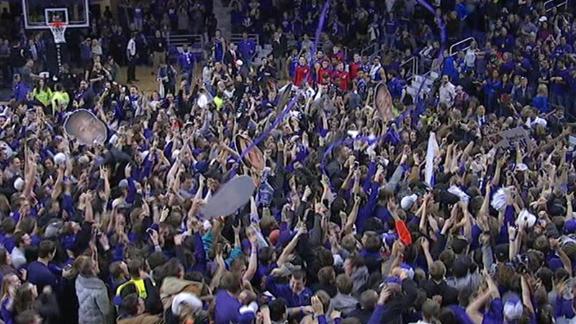On Court Rushes: In Need of Better Security, Not Regulation
Posted by Brian Goodman on February 24th, 2015In the minutes following Kansas State‘s upset win last night over Kansas, the focus of the social media conversation wasn’t on the reeling Jayhawks, which have now dropped their last three road games to reopen the Big 12 race. It wasn’t on the Wildcats, who — at least for one night — overcame maddening inconsistency and team chemistry issues to beat a team seven spots ahead of them in the league standings. Instead, it was about the tired topic of court-rushing. However, now that our own Chris Stone has addressed the storylines that are far more interesting (at least in my opinion) from the game itself and its impact on the Big 12 race, we can move on to the matter of what made last night’s postgame celebration tricky and what should be done to help keep everyone — players, coaches, team staffers and fans alike — safe in the fracas.
Fundamentally, I love everything that court-rushings represent to a student community. When executed without harm, they embody the close relationship between college athletes and the students who support them. In the constant news cycle of glorifying teams (or picking them apart) and evaluating individual players’ skill sets, it’s easy to forget that they’re also young adults who attend the same classes, eat at the same restaurants, hang out at the same bars and go to the same parties as many of the non-athletes in the student sections. There are tons of things that make college sports different than pro sports, and many of those things are problematic, to say the least, but the physical unification and celebration that takes place in the jubilant moments following a big win is one that is much simpler and easier to get behind.
At the same time, I understand that it doesn’t always play out as theorized, and that’s where you run into issues like the situation last night in Manhattan. By now, you’ve probably seen the Vine of one student stupidly going out of his way to antagonize Kansas forward Jamari Traylor. I won’t get into what should or shouldn’t be done about that specific fan, but for whatever it’s worth, university police is looking into it. You’ve also probably seen footage of head coaches Bill Self and Bruce Weber getting pinned against the scorer’s table. There’s also footage of Kansas assistant Kurtis Townsend physically grabbing another fan and pushing him away from the exiting Jayhawk team. No matter which team’s side you’re on (if you root for one of those teams), it’s a bad look. In response, Kansas State athletic director John Currie acknowledged that what happened last night can’t happen again, and the Big 12 is right there with him.
So what should be done? To answer that question, you first have to look at the circumstances that led to everything that went down. As Sam Vecenie of CBSSports.com points out, the game had been decided for minutes before the final buzzer. There was certainly enough time for arena security to take preventative action, whether that involved cordoning off the student section to slow the flood of fans onto the floor or simply making sure enough staffers were in place to form a barrier around the benches, allowing each team to retreat to their locker room without a problem. In past years, Bramlage Coliseum has played host to court-storms that have gone off without a hitch, as have many other gyms around the country, so it’s not like there’s an inherent inability to keep players, coaches and staffers safe in the aftermath of a big win. Security definitely didn’t do everything it needed to do last night, however, in order to prevent some of the chaos from happening.
The simplest solution isn’t to fine the schools, though I wouldn’t be fully against the idea, either. It definitely isn’t to make the home team forfeit the game in the event of an early rush. Why should some fans’ actions negate hours of hard work by players and coaches? Rather, the most logical and implementable solution is to take precautionary steps to ensure everyone’s safety while preserving the ability of those students to celebrate with their friends and the athletes. If instances like last night’s maelstrom become the norm rather than the exception, stronger action may in fact be required. But we’re not there yet.












































